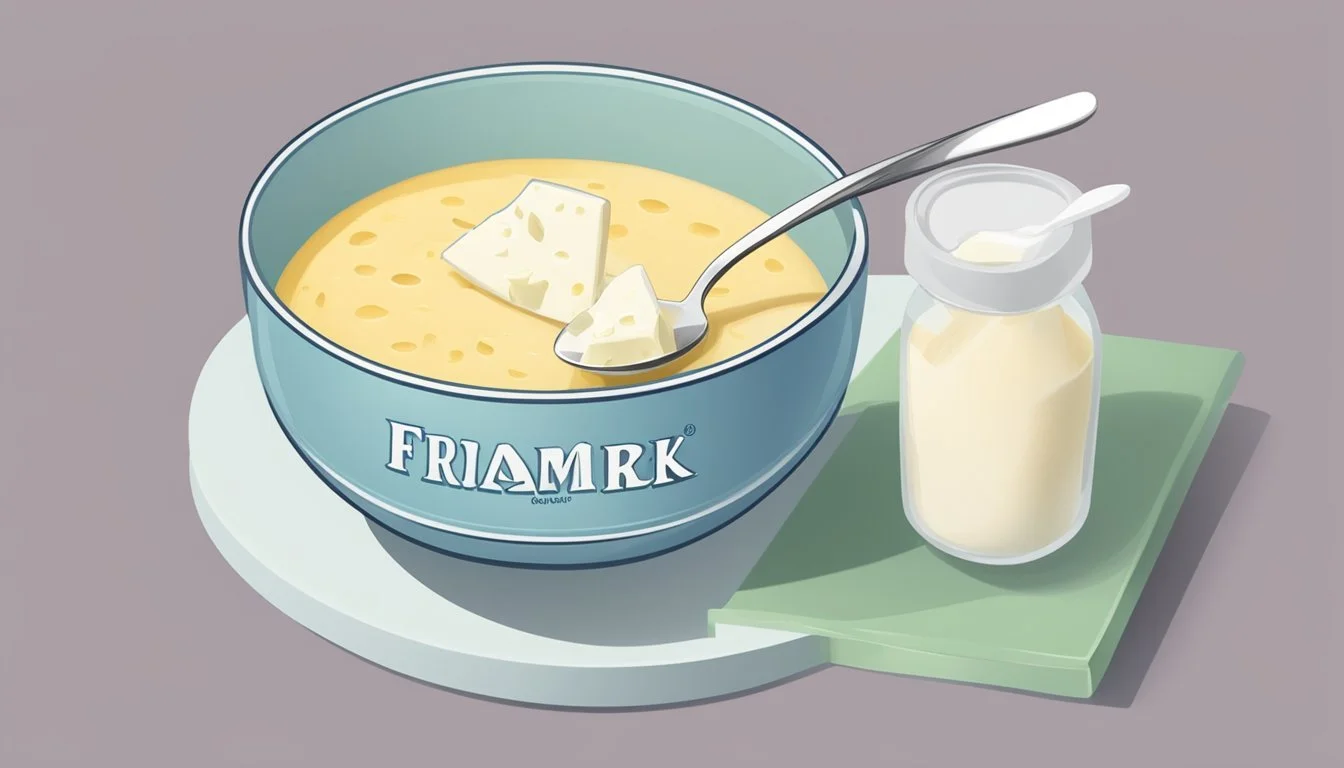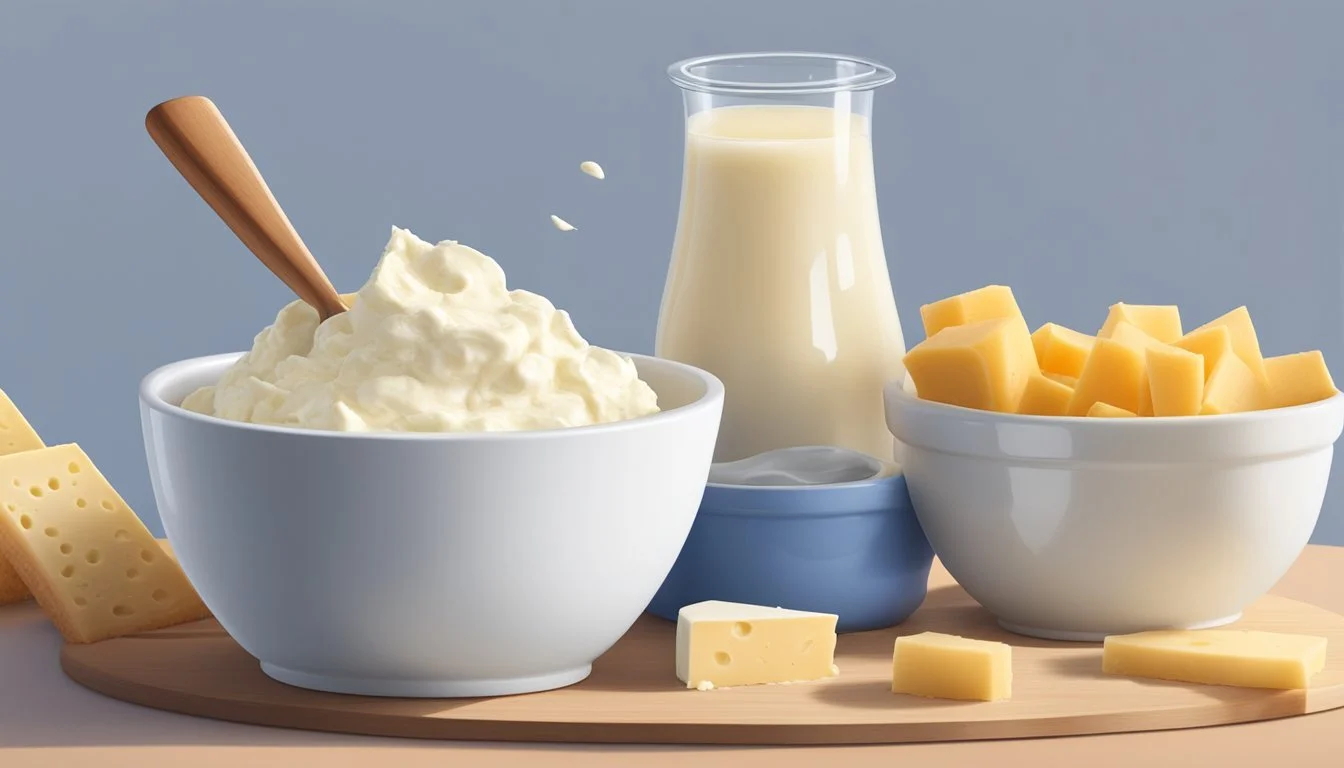How to Substitute Quark for Fromage Frais
Simple Dairy Alternatives
Quark and fromage frais are often featured in recipes for their creamy textures and subtle flavors, which can enhance a variety of dishes. While quark is a type of fresh cheese commonly used in German and Eastern European cuisine, fromage frais is a French cheese that shares a similar consistency and mild taste. Both are versatile ingredients in the kitchen, but there may be instances where a cook might need to substitute one for the other due to availability or dietary preferences.
Substituting quark for fromage frais can be a straightforward process. The texture and fat content of fromage frais can vary, so when looking for a quark substitute, it’s essential to consider the desired richness of the final dish. Full-fat fromage frais offers a creaminess that is closer to quark, while the low-fat variety might require the addition of another higher fat dairy product to achieve a comparable richness.
The mild and slightly tangy flavor of quark makes it a suitable alternative for fromage frais in many recipes, including both savory and sweet preparations. When using quark as a fromage frais substitute, cooks may adjust the seasoning or fat content to better mimic the nuanced taste and texture of fromage frais, ensuring that the end product maintains the balance and character of the original recipe.
Understanding Dairy Products
In the realm of dairy products, particularly those with a European lineage like quark and fromage frais, understanding the nuances in texture, fat content, and culinary uses is crucial for effective substitution.
Differences Between Quark and Fromage Frais
Quark, originating from Germany, and fromage frais from France, are both fresh cheeses (What wine goes well with fresh cheeses?) but they vary in several aspects:
Texture: Quark usually possesses a smoother and more spreadable texture compared to the slightly looser structure of fromage frais.
Fat Content: While quark can range in fat content, it typically has a lower fat content than some varieties of fromage frais.
Curd Formation: Both are made with the help of lactic acid bacteria, but the curd in quark is not strained as extensively as in fromage frais, leading to a denser cheese.
Culinary Uses: They can be used interchangeably in recipes; however, fromage frais is often preferred for its fluffier consistency when whipped.
Overview of Quark
Quark is a type of fresh cheese popular in Germany. It is made by warming sour milk until it curdles and then straining it to varying degrees. Quark's key characteristics include:
Texture: It is dense yet creamy, akin to a blend between yogurt and cottage cheese (how long does cottage cheese last?).
Fat Content: It comes in different fat levels—low-fat to full-fat options.
Utilization: Commonly used in both sweet and savory dishes, it is versatile and can be seasoned or flavored to one's preference.
Overview of Fromage Frais
Fromage frais is another variety of fresh cheese, and it is often associated with French cuisine. The cheese is made by adding lactic acid bacteria to milk, which thickens it and gives it a creamy consistency. The distinctive features of fromage frais are:
Texture: It is creamy with a consistency that is similar to that of sour cream but can be whipped to a fluffier texture.
Fat Content: Typically higher in fat than quark, it can range from light to full-fat versions.
Culinary Role: It shines in dishes that require a subtle tanginess, often used in desserts or as an accompaniment to fresh fruits.
By understanding these dairy products' varied characteristics, one is better equipped to substitute quark for fromage frais effectively.
Nutritional Profiles
When substituting quark for fromage frais, the nutritional content of the two dairy products must be considered as health priorities and dietary requirements vary for individuals. Understanding their protein, fat, and nutrient content is crucial for making an informed choice.
Protein Content and Health Benefits
Quark typically has a high protein content, which is essential for muscle repair and growth. It often contains around 14 grams of protein per 150-gram serving. Fromage frais, on the other hand, also offers a good protein supply, although its protein content can be slightly lower, at approximately 8 grams per similar serving size. These protein-rich foods provide health benefits like sustaining muscle health and aiding in satiety.
Fat Content Variations
The fat content in quark can vary significantly depending on whether you choose full-fat, low-fat, or fat-free varieties. Full-fat versions can contain up to 10 grams per serving, while low-fat versions average 2 grams, and fat-free options may contain no fat at all. In contrast, fromage frais comes in similar varieties, offering consumers options to reduce fat intake if desired. The low-fat version typically has around 1.5 grams per serving, aligning it closely with low-fat quark.
Calcium and Other Nutrients
Both quark and fromage frais are excellent sources of calcium, vital for bone health. A serving of quark provides around 120 milligrams of calcium, while fromage frais offers approximately 100 milligrams. Besides calcium, they are also sources of other important nutrients such as phosphorus, vitamin A, and sometimes vitamin D, depending on fortification. However, the specific vitamin and mineral content can fluctuate based on the manufacturing process and fortification.
Culinary Uses
When substituting quark for fromage frais, one should consider the end-use, whether in baking, cooking, or as an addition to cold dishes. The ideal substitute not only mimics the original ingredient's texture but also its role as a flavor component in the dish.
Substitutions in Baking
In baking, quark can replace fromage frais to provide a smooth texture and mild flavor. It works particularly well in cheesecakes or pastries, where its slightly different tanginess won’t overpower the sweet notes of the dessert. Bakers may find it useful for its ability to maintain creaminess without altering the structure of the baked goods.
Cheesecakes: Quark can be used one-for-one in place of fromage frais for a creamy and lush consistency.
Pastries: Incorporate quark to achieve a delicate and soft interior.
Creamy Textures in Cooking
Quark offers a creamy texture that is excellent for savory dishes requiring a touch of creaminess. It seamlessly blends into sauces and soups, contributing to a rich mouthfeel without overwhelming the dish’s flavor profile.
Sauces: Useful in creating velvety sauces, quark balances the need for creaminess with a desire to keep flavors focused.
Soups: Adding quark to soups enhances texture while keeping the taste profile grounded and neutral.
Fresh Tastes in Salads and Toppings
The application of quark as a topping or in salad dressings introduces a refreshing element. Its bland taste compared to fromage frais allows the fresh ingredients of the salad to shine through, while still contributing a lush mouthfeel.
Salad Dressings: Quark can create dressings that are thick and rich, yet don't overshadow the salad components.
Toppings: Whether spooned over baked potatoes or stirred into a fruit salad, quark retains a subtly tangy profile that enhances the overall dish.
Quark as a Substitute
Incorporating quark as a substitute for fromage frais requires attention to flavor, texture, and how it interacts with other recipe components. This section outlines practical ways to utilize quark effectively in various culinary situations.
Balancing Flavor and Consistency
When substituting quark for fromage frais, one must consider the flavor profile and the desired consistency of the dish. Quark has a milder taste and a thicker texture compared to fromage frais. To achieve a similar consistency, quark can be mixed with a bit of milk or water. If a tangier flavor akin to fromage frais is desired, a small amount of lemon juice or vinegar can be added. It is vital to moderate these additions to avoid overpowering the dish.
Flavor adjustment: Add lemon juice or vinegar for tanginess
Consistency modification:
Mix with milk for a thinner consistency
Use as is for a thicker texture
Adapting Recipes with Quark
Substituting quark in recipes originally calling for fromage frais involves more than a direct swap; one must adapt the amount used and consider the overall flavor. Quark can replace fromage frais in equal measure, but because of its thicker nature, it is excellent for fillings and spreads. In baking, it can contribute to a moist and dense texture. If a recipe requires a lighter texture, quark can be blended until smooth or mixed with a bit of ricotta or Greek yogurt to introduce more airiness.
Recipe adjustment: 1:1 ratio, with potential blending for smoothness
Inclusion with other ingredients:
Blend with ricotta for a lighter consistency
Combine with Greek yogurt to maintain protein levels without added fat
Quark in Diet-Specific Recipes
Quark is a suitable ingredient for those following vegetarian and gluten-free diets. Its versatility as a fromage frais substitute is valuable for various dietary requirements. Quark is naturally gluten-free, making it an excellent option for gluten-sensitive individuals. For vegetarians, quark serves as a nutrient-rich source of protein similar to cottage cheese but offers a different texture and can be used in sweet or savory dishes. When substituting for fromage frais, ensure other recipe ingredients abide by the specific dietary restrictions.
Vegetarian recipes: Use quark as a protein-rich cheese alternative
Gluten-free recipes: Verify that quark and other ingredients meet gluten-free standards
Practical Tips for Substitution
When substituting quark for fromage frais, one needs to consider the fat content and texture to achieve a similar creaminess, especially in desserts. Adjusting these factors ensures the closest match in both consistency and flavor.
Adjusting Fat Content When Substituting
Fromage frais typically has a lower fat content compared to some quark varieties. To reduce the fat content of quark:
Mix with low-fat yogurt: This can balance out the overall fat content without significantly altering the texture.
For increased fat content in a recipe that may require a richer consistency similar to mascarpone:
Blend quark with a bit of heavy cream to enrich the texture.
Ensuring Proper Texture
The texture of fromage frais is smooth and spreadable. To replicate this with quark:
Strain through cheesecloth if the quark is too wet, which contributes to a firmer texture similar to fromage frais.
Whisk quark before using it to ensure smoothness and eliminate any potential curds.
Incorporating Quark into Desserts
Quark's unique texture makes it suitable for desserts that call for fromage frais. Here's how to best incorporate it:
Cheesecakes: Quark can be a direct substitute due to its similar creaminess.
Mix with ricotta cheese or crème fraiche: To mimic the delicate texture in dessert recipes, blend equal parts of quark and ricotta or crème fraiche.
Shopping and Storage
When looking for fromage frais or quark, one must be mindful of where to shop and how to store these products to maintain freshness and flavor.
Finding Quark and Its Alternatives in Markets
Consumers can find quark cheese and its alternatives such as cream cheese (how long does cream cheese last?), Greek yogurt, or cottage cheese in most supermarkets. They are often placed in the dairy section, alongside other cheese or yogurt products. Look for fromage frais alternatives like Greek yogurt and cream cheese which can be easier to find compared to quark. If a consumer is seeking a vegan option, alternatives like almond cheese may also be available in markets that cater to plant-based diets. When shopping, pairing choices such as fruits, bread, or crackers can also be considered, as these items complement the creamy textures and flavors of quark and its substitutes well.
Storage Best Practices for Quark
Proper storage is crucial to maintain the quality of quark cheese and fromage frais. After purchase, these products should be:
Kept refrigerated; ideally at temperatures between 1°C and 4°C (34°F and 39°F).
Stored in their original packaging until opened.
Once opened, they should be covered with a tight seal or transferred to an airtight container to prevent spoilage.
For longer shelf life, one might also consider mixing quark with honey, which acts as a natural preservative due to its antibacterial properties. Consume these dairy products before the best before date, and always inspect the texture and smell before use to ensure they are still fresh.
Customizing with Quark
When substituting quark for fromage frais, one has access to a versatile ingredient that can be customized for both sweet and savory dishes. Through the incorporation of mix-ins and an understanding of its application in various recipes, quark serves as a highly adaptable component.
Quark Mix-Ins for Enhanced Flavors
To infuse quark with robust flavors, one may consider stirring in herbs for savory dishes or vanilla and a hint of sweetness for desserts. The addition of fresh or dried fruits can create a balanced and enticing flavor profile suitable for a mousse or a sweet dish.
Herbs: Chives and dill are excellent for savory quark blends.
Fruits: Berries or citrus zest can brighten sweet quark mixtures.
Quark in Sweet and Savory Applications
Quark's versatility shines in its application across a range of recipes, elevating both sweet and savory creations in French gastronomy and beyond.
Sweet Applications:
Tarts and pastries: Quark can be used as a filling, providing a creamy texture.
Granola and muesli: A dollop of quark with vanilla or honey complements these breakfast favorites.
Savory Applications:
Baked potatoes: Topped with herbed quark, they become a delightful dish.
Savory tarts: Quark can create a rich, flavorful base for vegetables and meats.
Alternative Dairy and Non-Dairy Options
When substituting quark for fromage frais, individuals have a variety of alternative dairy and non-dairy options. They can explore plant-based substitutes or different dairy products that can mimic the texture and taste of fromage frais.
Using Tofu and Vegan Cream Cheese
For a plant-based alternative, tofu can serve as a decent substitute for fromage frais. Specifically, soft tofu can be blended until smooth, and with a touch of lemon juice for tanginess, it mimics the creamy consistency of fromage frais. Here is a simple guide on how to use tofu as a substitute:
Blend soft tofu until creamy.
Add lemon juice and salt to taste for a tangy flavor.
Adjust thickness by adding a small amount of plant-based milk if needed.
Vegan cream cheese is another suitable substitute, especially in spreads and dips. Although its consistency is slightly firmer than fromage frais, it carries a similar mild flavor profile.
Exploring Other Dairy and Cheese Variants
Those who prefer dairy options have several choices. Goat cheese offers a tangy flavor with a creamy texture not unlike fromage frais. It works especially well in recipes where a stronger cheese flavor is conducive to the dish's profile.
Goat cheese: A tangy yet smooth option for spreads and dips.
Labneh, strained cow or goat’s milk yogurt, is thicker than fromage frais but shares a similar tartness. By adding a bit of skim milk or whole milk, one can adjust the consistency to resemble fromage frais more closely. Below is a quick instruction on using labneh:
Mix labneh with milk to adjust consistency.
Add lemon juice to replicate the slight acidity found in fromage frais.
In addition, combining heavy cream with a dash of butter can create a richer substitute that's especially suitable for recipes where fat content plays a pivotal role.
Conclusion
When substituting quark for fromage frais, cooks can achieve similar textures and flavors in their recipes. The difference between these two dairy products is primarily the fat content and the texture. Fromage frais is a creamy soft cheese with a lower fat content, while quark is similar but can be slightly grainier and less creamy.
To replicate the creaminess of fromage frais, blending full-fat cottage cheese until smooth can be an effective method. Greek yogurt is also a suitable alternative thanks to its thick consistency and creaminess, albeit with a tangier taste. For those who require a lower-fat option, low-fat fromage frais can be fortified with a higher fat dairy product to match quark's richer quality.
Below is a summarization of suitable substitutes:
Full-fat cottage cheese: blended to achieve smoothness.
Greek yogurt: offers creaminess but with additional tanginess.
Créme Fraiche: provides a smooth texture and thickness, but more tangy.
Incorporating these substitutes into recipes calls for attention to flavor profiles and desired consistency, as minor adjustments might be necessary to achieve the perfect balance for the intended dish. Each alternative brings unique qualities to the table, and chefs should select the one that best complements the other ingredients in their recipe.
Appendix
This section provides detailed information to enhance the reader's understanding of dairy substitutions, specifically concerning replacing quark with fromage frais. The glossary introduces key dairy terms, while FAQs address common queries related to the substitution process.
Glossary of Dairy Terms
Quark: A type of fresh dairy product, similar to cottage cheese, that is creamy with a mild flavor.
Fromage Frais: A smooth, creamy fresh cheese common in French cuisine, often used in sauces and desserts.
Curds: Coagulated milk solids that form cheese or are used in products like quark.
Creaminess: The rich, smooth texture often desired in dairy products.
Slightly Tangy: A description of the mild acidity that is present in dairy products like quark and yogurt.
Cheesecloth: A loose-woven gauze-like cotton cloth used in cheese production and for straining.
Calcium: An essential mineral found in high amounts in dairy products.
Rennet: An enzyme used in the cheese-making process, which can be of animal or vegetarian origin.
Plain Yogurt: A fermented dairy product with a creamy texture and a tangy flavor, often used as a substitute for quark.
Ricotta Cheese: A soft Italian cheese with a grainy texture and slightly sweet taste, used in dishes like lasagna and cheesecakes.
Lemon Juice: An acidic liquid that can promote milk coagulation when making fresh cheese.
Cheesecakes: A dessert consisting of layers, typically made up of a mixture including cream cheese or other dairy alternatives like quark.
Frequently Asked Questions
Can plain yogurt replace fromage frais in cheesecakes?
Yes, plain yogurt can substitute fromage frais in cheesecakes due to its similar creaminess and slight tang.
What is an easy way to substitute quark in a dip?
Mix a high-fat dairy item like full-fat cottage cheese with lemon juice to mimic quark's texture and tartness in dips.
Is there a vegetarian option to rennet when making cheese at home?
Vegetarian rennet, derived from microbial sources, is widely available and can be used as an alternative to animal rennet.
How can I replace fromage frais in fruit sauces while retaining calcium content?
Ricotta cheese or calcium-fortified plain yogurt can provide creaminess and maintain calcium levels in fruit sauces.
What’s the difference between using cheesecloth and strainers for dairy substitutes?
Cheesecloth allows for finer straining of curds from whey, resulting in a smoother, creamier consistency compared to standard strainers.











